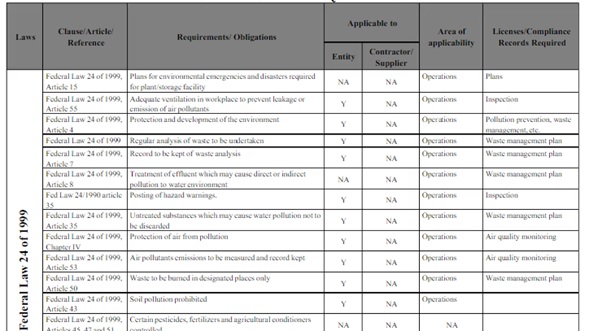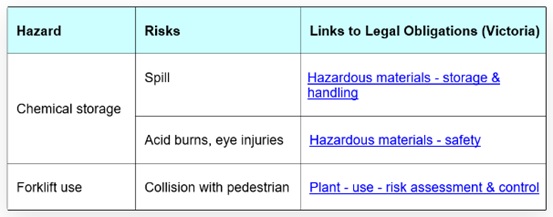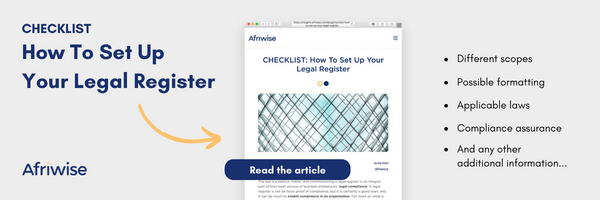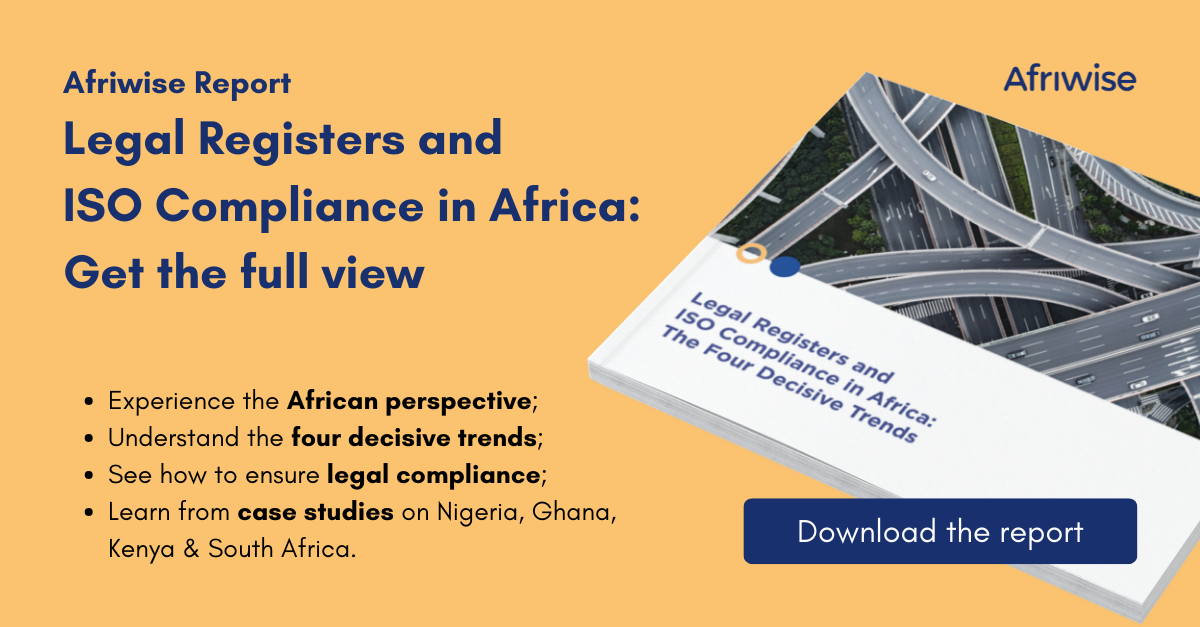Your organisation may be considering commissioning a legal register. There may be some doubts as to what a legal register encompasses and what it actually looks like. These are common considerations for many organisations considering their legal register options. That should not be surprising, since a legal register is a serious undertaking.
This article will seek to clarify what a legal register looks like, which must include its key characteristics and what it typically encompasses. This will be achieved by answering a series of hypothetical questions that are typical of those that may be asked by clients when seeking out professional assistance from a legal consultancy, such as that offered by Afriwise for clients doing business in Africa.
What is a legal register fundamentally about?
As its names suggests, a legal register is a repository of law. For further clarity, it should be noted that ‘law’ or ‘legal’ encompasses a wide range of different legal documents, functions and attributes. These can include legislation, regulations, codes, directives and other legal items to which all or specified organisations are legally bound to adhere to. These laws can be those passed by national/federal authorities, as well as those at the state/provincial/county and local/city/area levels, depending on the legal system of a given jurisdiction. ‘Law’ also refers to any international conventions and protocols that fall under international treaty law, where applicable for an organisation.
One should think of a legal register as the ‘legal go-to’ for any and all aspects relevant to the legal compliance requirements attributable to an organisation. Logically, just like any citizen, no entity can ‘pick or choose’ the laws to which it is bound by statute or otherwise. The legal system of any country is a social contract to which everyone is bound, including corporations and other entities. Therefore, the legal register is the de facto hallmark of that social contract to which any organisation must adhere.
Why do so many organisations opt for legal registers?
Literally every entity on Earth has to operate to some extent within the framework and confines of applicable laws and legal system. Any contravention of law is of course illegal and can result in penalties or fines and even criminal charges against a legal entity or organisation and even those who embody it, such as executive managers or other people deemed a ‘responsible person’ under a given law. It can also result in civil action against an entity or its executive function. It therefore makes sense that compliance to law is of paramount importance in any organisation because non-compliance or contravention could have serious repercussions.
To understand why legal registers are considered important, one has to understand the critical importance of legal compliance, also sometimes referred to (although not entirely correctly) as regulatory compliance. For the purpose of this article, a viable definition of the term is important: “Legal compliance stands for the structured observance of legal regulations to which companies are subject. In day-to-day business practice, countless laws and requirements from the government must be complied with. Legal compliance attempts to structure and manage this compliance and make it practicable within the company.”
Why is the ‘scope’ of a legal register important?
Not all legal registers are the same since not all legal registers are for the same purpose. Different needs, different parameters.That is why scoping a legal register is so important, in that it creates the focus, depth and breadth of legal coverage required by an organisation. So, for example, an organisation may opt for a environmental legal register that pertains solely to the environmental laws to which is needs to comply. Other entities may opt to have a fully-inclusive or full-scope legal register that includes all laws relevant to its legal functioning, including those for occupational health and safety, employment and labour rights, financial reporting, consumer privacy rights, emergency response and management, and so forth.
Nor does every legal register cover the entirety of an organisation. This is very often the case, in that a legal register may be scoped to only cover a specific location or facility, given department or organisational process for a very specific purpose. So, for example, a production facility of a manufacturing company may opt to have a legal register specifically for the facility. Furthermore, the same facility may only require a health and safety register, given that it intends to eventually be certified as an ISO 45001 facility in terms of its occupational health and safety management system. That same certification process, including acquisition and management of the relevant legal register, may in turn serve as a ‘testing ground’ for other facilities or stand-alone departments, such as its research and development (R&D) department or logistics function.
What does a legal register actually include?

A legal register should be the sum total of all laws that may be applicable to an organisation. That in itself implies that the content of the legal register may vary greatly, depending on an organisation’s specific criteria, as discussed above.
More common to legal registers is the form that they take, i.e. features commonly found in nearly all registers. These should typically include:
Applicable laws derived from different legal sources, including:
- Legislation, whether federal/national or state/provincial;
- Laws, including ordinances or by-laws at the local level, however ‘local’ may be ascribed in a jurisdiction;
- Regulations, typically derived from specific legislation and as mandated and overseen by specific government departments or agencies;
- International treaties, including conventions and protocols; and/or
- Industry standards that may have been codified in law aimed solely and specifically at a given industry sector or type of work, and so forth.
It should be noted that ‘law’ in its entirety will differ substantially between different jurisdictions/countries due to their legal traditions. For most of Africa, a legal system will depend to a significant extent on whose colony a country may have been prior to independence. So, for example, the type of law covered in a legal register in an African country with a common law system (i.e. based on English law), such as South Africa, Kenya or Nigeria, will differ to that found in African countries with codified or civil law systems (i.e. based on French, Portuguese or Belgian law, or ‘Napoleonic law’), such as Angola, the DRC or Senegal.
Information about specific laws may also be noted in the register, including:
- The full name or title of the law;
- The year of the law’s promulgation or commencement;
- The governing department that oversees and enforces the law; and
- Other defining aspects or information about the law.
Another important feature common to many legal registers is the inclusion of extracts of the law with their applicable citations. Doing this offers needed context, by which someone reading the register can understand where and to which process a specific legal requirement may be relevant.
These extracts may be directly copied from the legal text or there may be a simplified interpretation thereof. This simplification of legal text is often necessary because legal language or jargon (i.e. ‘legalese) can often be very complex and downright confusing! That is when (and why) having the inputs of a professional legal consultancy, such as Afriwise, can be so beneficial, because they can help you make sense of what is sometimes exhaustingly convoluted legal text, often written in highly formal, even arch language. Unfortunately, many legislators seem to have no concept of understandable language that is crisp and succinct, opting instead for sentences that seem to run on endlessly and containing multiple clauses.
What about laws that change or become obsolete?
Law is of course not static. Legislation changes and regulations and other legal instruments are amended or scrapped as societies evolve and paradigm shifts occur within legal systems. Laws also often become updated and simply need to be modernised. This reality needs to be reflected in a good legal register. That is why amendments should be an integral part of any legal register. Thankfully, updating legal registers in Africa has become easier as more and more African governments have been launching websites that provide legal news and government reports.
It is worth noting here that registers typically come in one of two formats: electronic (digital) or hard copy (paper-based). The format of a legal register will be highly determinative in how legal updates can be added to a register. Unsurprisingly, it is far easier to update electronic registers, given that amendments can be done digitally and remotely, i.e. by the consultancy charged with compiling and regularly updating the register. Internal legal or risk management departments can also be tasked with providing updates, although few companies opt for this.
Paper-based amendments/changes to legal registers are more time-consuming and logistically tricky. However, that was the way most legal registers were updated until the early 2000s and the advent of software and cloud computing that made digital updates far easier and more efficient.
Something else worth noting is that amendments to law are often to selected provisions within a given piece of legislation, rather than an entire repeal of said legislation. That means that certain legal requirements within a law may change although others remain the same. Furthermore, some amendments may necessitate a re-interpretation of other, non-amended clauses or provisions. That can be very challenging to grasp for the legally-uninitiated, which is a further reason why having a professional legal consultancy in charge of your legal register can be so beneficial.
Is actual compliance noted in a legal register? If so, how so?
Yes, compliance (or not) to relevant law contained within a register can be noted. This makes sense since legal compliance is at the heart of why organisations commission, compile and maintain legal registers. Legal compliance is a leading concern for almost any entity, as noted at the beginning of this article, which is why notations of compliance (or not) are considered a key attribute of legal registers by many legal consultancies and clients alike.
An assessment of legal compliance can be noted in two different ways inside a legal register:
1. Status of compliance: This will note the extent to which a specific legal requirement is being adhered to. For example, a notation next to a legal requirement may have an entry of ‘Fully compliant,’ ‘Partially compliant’ or ‘Non-compliant’. This assessment can either be done internally or by a third-party legal service. The compliance status of key legal provisions within a register can be especially important to ascertain prior to a legal compliance audit, such as that which a company might undertake prior to having a certification audit for a given ISO standard, such as ISO 14001 or ISO 450001.
2. Evaluation of compliance: this is a more formal process that involves an actual audit or similar legal compliance process that critically evaluates compliance legal requirements. These are typically (and best) done by third-party legal consultancies or law firms that specialize in legal compliance audits. Often, these legal auditors are specialists in a given field, such as compliance relating to IT privacy and security. Government entities may even prescribe guidelines on how external legal compliance assessments should be conducted, such as those prescribed by the European Commission regarding environmental compliance audits.
3. Companies will often spend a lot of time and effort in having these audits done, precisely so that the full extent of their compliance can be objectively assessed and any glaring non-compliance issues established. These legal compliance audits, like any third-party audits, can be quite costly, particularly if the facility being audited is large and/or complex. Furthermore, auditing costs have been rising significantly in recent years in lock-step with the sharp rise generally in compliance costs, as noted by Deloitte. Even so, clients continue to nevertheless find value in having them done, if only to minimize their legal risk profile where possible.
So, what does a legal register physically look like?
There is no ‘generic-looking’ type of register because there are so many factors that determine the scope and inputs of legal registers. The required focus of the register will determine its format and layout. Some registers focus on the applicable legislation itself. For example, below is a snapshot of a legal register outlining provisions relating to an environmental law in the United Arab Emirates (UAE):
Courtesy: Scribd
Generic templates of existing laws do exist, of course, but even these usually have to be customized in order to meet the specific legal context and requirements of organisations.
Then there are those legal registers that focus on other systemic elements, such as specific tasks or the risk profile of an organisation. An example of the latter can be seen in the screenshot below of an electronic health and safety register focused on hazards and risks and the corresponding legal requirements under the state law of Victoria in Australia, which a user would access by clicking on the appropriate hyperlink:
Courtesy: Environment Essentials
Key Takeaways...
Legal compliance can be challenging for any organisation, difficult even. Risk abounds in many different forms, putting an organisation on the ‘precipice’ of non-compliance in a way that seems ever-present and never-ending. Non-compliance can be very costly for any organisation, whether in terms of fines or other legal costs accrued or damage to reputation or brand. It can even be deadly for employees in terms of their health and safety.
As such, every effort needs to be made to ensure that compliance to applicable laws is (1) identified, (2) compiled, (3) managed and (4) amended, as needed. A well-formulated legal register that is context-driven and fit for purpose can go a long way in ensuring that compliance is not only possible and manageable, but in lock-step with the risk profile of your organisation.
How about the African perspective?
Well, don't get stumped on how ISO compliance and legal registers are being rolled out across the continent — just have a look at our latest report:
- Discover the four trends in ISO compliance from an African perspective;
- Get an overview of ISO Standards, and their need for legal registers;
- See how other African companies are implementing them;
- Learn from case studies on Nigeria, Ghana, Kenya & South Africa.

